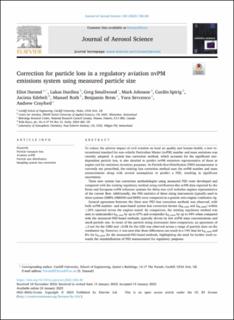Please use this identifier to cite or link to this item:
https://doi.org/10.21256/zhaw-30293Full metadata record
| DC Field | Value | Language |
|---|---|---|
| dc.contributor.author | Durand, Eliot | - |
| dc.contributor.author | Durdina, Lukas | - |
| dc.contributor.author | Smallwood, Greg | - |
| dc.contributor.author | Johnson, Mark | - |
| dc.contributor.author | Spirig, Curdin | - |
| dc.contributor.author | Edebeli, Jacinta | - |
| dc.contributor.author | Roth, Manuel | - |
| dc.contributor.author | Brem, Benjamin | - |
| dc.contributor.author | Sevcenco, Yura | - |
| dc.contributor.author | Crayford, Andrew | - |
| dc.date.accessioned | 2024-03-16T10:32:41Z | - |
| dc.date.available | 2024-03-16T10:32:41Z | - |
| dc.date.issued | 2023-01-24 | - |
| dc.identifier.issn | 0021-8502 | de_CH |
| dc.identifier.uri | https://digitalcollection.zhaw.ch/handle/11475/30293 | - |
| dc.description.abstract | To reduce the adverse impact of civil aviation on local air quality and human health, a new international standard for non-volatile Particulate Matter (nvPM) number and mass emissions was recently adopted. A system loss correction method, which accounts for the significant size-dependent particle loss, is also detailed to predict nvPM emissions representative of those at engine exit for emissions inventory purposes. As Particle-Size-Distribution (PSD) measurement is currently not prescribed, the existing loss correction method uses the nvPM number and mass measurements along with several assumptions to predict a PSD, resulting in significant uncertainty. Three new system loss correction methodologies using measured PSD were developed and compared with the existing regulatory method using certification-like nvPM data reported by the Swiss and European nvPM reference systems for thirty-two civil turbofan engines representative of the current fleet. Additionally, the PSD statistics of three sizing instruments typically used in these systems (SMPS, DMS500 and EEPS) were compared on a generic aero-engine combustor rig. General agreement between the three new PSD loss correction methods was observed, with both nvPM number- and mass-based system loss correction factors (kSL_num and kSL_mass) within ±10% reported across the engines tested. By comparison, the existing regulatory method was seen to underpredict kSL_num by up to 67% and overpredict kSL_mass by up to 49% when compared with the measured-PSD-based methods, typically driven by low nvPM mass concentrations and small particle size. In terms of the particle sizing instrument inter-comparison, an agreement of ±2 nm for the GMD and ±0.08 for the GSD was observed across a range of particle sizes on the combustor rig. However, it was seen that these differences can result in a 19% bias for kSL_num and 8% for kSL_mass for the measured-PSD-based methods, highlighting the need for further work towards the standardisation of PSD measurement for regulatory purposes. | de_CH |
| dc.language.iso | en | de_CH |
| dc.publisher | Elsevier | de_CH |
| dc.relation.ispartof | Journal of Aerosol Science | de_CH |
| dc.rights | https://creativecommons.org/licenses/by/4.0/ | de_CH |
| dc.subject | Particle transport loss | de_CH |
| dc.subject | Aviation | de_CH |
| dc.subject | Non-volatile Particulate Matter (nvPM) | de_CH |
| dc.subject | Particle size distribution | de_CH |
| dc.subject | Sampling system loss correction | de_CH |
| dc.subject.ddc | 629: Luftfahrt- und Fahrzeugtechnik | de_CH |
| dc.title | Correction for particle loss in a regulatory aviation nvPM emissions system using measured particle size | de_CH |
| dc.type | Beitrag in wissenschaftlicher Zeitschrift | de_CH |
| dcterms.type | Text | de_CH |
| zhaw.departement | School of Engineering | de_CH |
| zhaw.organisationalunit | Zentrum für Aviatik (ZAV) | de_CH |
| dc.identifier.doi | 10.1016/j.jaerosci.2023.106140 | de_CH |
| dc.identifier.doi | 10.21256/zhaw-30293 | - |
| zhaw.funding.eu | No | de_CH |
| zhaw.issue | 106140 | de_CH |
| zhaw.originated.zhaw | Yes | de_CH |
| zhaw.publication.status | publishedVersion | de_CH |
| zhaw.volume | 169 | de_CH |
| zhaw.publication.review | Peer review (Publikation) | de_CH |
| zhaw.author.additional | No | de_CH |
| zhaw.display.portrait | Yes | de_CH |
| Appears in collections: | Publikationen School of Engineering | |
Files in This Item:
| File | Description | Size | Format | |
|---|---|---|---|---|
| 2023_Durand-etal_Corrections-particle-loss-regulatory-aviation-nvPM_jaerosci.pdf | 6.7 MB | Adobe PDF |  View/Open |
Show simple item record
Durand, E., Durdina, L., Smallwood, G., Johnson, M., Spirig, C., Edebeli, J., Roth, M., Brem, B., Sevcenco, Y., & Crayford, A. (2023). Correction for particle loss in a regulatory aviation nvPM emissions system using measured particle size. Journal of Aerosol Science, 169(106140). https://doi.org/10.1016/j.jaerosci.2023.106140
Durand, E. et al. (2023) ‘Correction for particle loss in a regulatory aviation nvPM emissions system using measured particle size’, Journal of Aerosol Science, 169(106140). Available at: https://doi.org/10.1016/j.jaerosci.2023.106140.
E. Durand et al., “Correction for particle loss in a regulatory aviation nvPM emissions system using measured particle size,” Journal of Aerosol Science, vol. 169, no. 106140, Jan. 2023, doi: 10.1016/j.jaerosci.2023.106140.
DURAND, Eliot, Lukas DURDINA, Greg SMALLWOOD, Mark JOHNSON, Curdin SPIRIG, Jacinta EDEBELI, Manuel ROTH, Benjamin BREM, Yura SEVCENCO und Andrew CRAYFORD, 2023. Correction for particle loss in a regulatory aviation nvPM emissions system using measured particle size. Journal of Aerosol Science. 24 Januar 2023. Bd. 169, Nr. 106140. DOI 10.1016/j.jaerosci.2023.106140
Durand, Eliot, Lukas Durdina, Greg Smallwood, Mark Johnson, Curdin Spirig, Jacinta Edebeli, Manuel Roth, Benjamin Brem, Yura Sevcenco, and Andrew Crayford. 2023. “Correction for Particle Loss in a Regulatory Aviation nvPM Emissions System Using Measured Particle Size.” Journal of Aerosol Science 169 (106140). https://doi.org/10.1016/j.jaerosci.2023.106140.
Durand, Eliot, et al. “Correction for Particle Loss in a Regulatory Aviation nvPM Emissions System Using Measured Particle Size.” Journal of Aerosol Science, vol. 169, no. 106140, Jan. 2023, https://doi.org/10.1016/j.jaerosci.2023.106140.
Items in DSpace are protected by copyright, with all rights reserved, unless otherwise indicated.